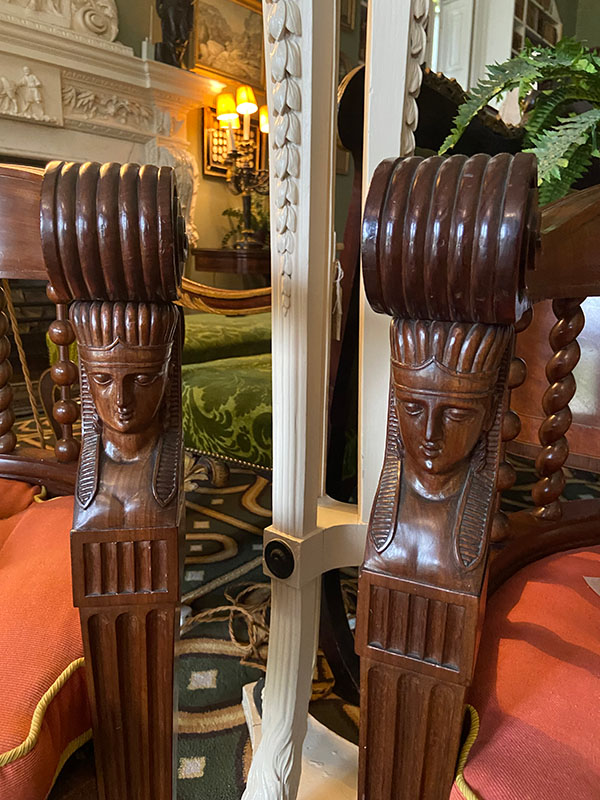British Country Houses through the Lens of Egyptomania and Orientalism
by Lea C. Stephenson
The Attingham Summer School was invaluable for object-based research and access to British country houses relevant to my dissertation on Egyptomania and late-19th-century Orientalism. Thanks to a Continuing Education Grant from the Decorative Arts Trust to the American Friends of Attingham, a scholarship enabled my participation in the program. Over the nearly three-week course, I immersed myself in domestic spaces and collections. As a scholar working on materiality and sensorial interiors, I found Attingham’s close-looking moments and access to objects invaluable, whether crawling beneath a Chippendale table to uncover details or studying the pigments of a watercolor landscape.
My dissertation focuses on what I term second-wave Egyptomania (c. 1870–1922) and includes late-19th-century American and British artists, collectors, and travelers reinterpreting Egypt amidst British imperialism. Numerous British country houses incorporated Egyptian souvenirs and Egyptian Revival motifs. For example, obelisks and sphinxes appeared constantly across gardens and interiors, typically representing earlier iterations of Egyptomania in the late 18th and early 19th centuries. Through these encounters, I saw how a reimagined Egypt could be seamlessly incorporated into domestic spaces. Several 18th-century designs included subtle decorative nods to Egypt, including bookcases, candelabra, and furniture suites.
Studying Thomas Chippendale II Egyptian Revival mahogany chairs (1805, figure 1) in the library at Stourhead in Wiltshire illustrated how patrons interacted with Egyptian-inspired decoration and re-presented Egyptian statuary in Britain. Examining this furniture in person underscored the nature of sensorial domestic spaces. For instance, how clients might touch the sphinx heads. I also found studying this earlier wave of Egyptomania particularly useful when considering how designers interpreted Orientalism prior to touring Egypt and how these motifs reappeared again by the late 19th century when direct access was more common.
Access to various houses and private spaces during the program introduced me to Egypt-related objects and materials (especially Grand Tour souvenirs) that will impact my dissertation and future work on Anglo-American Orientalism. Visiting houses and sites during Attingham that do not have collection databases or extensive documentation acquainted me with new forms of Egyptomania, whether garden designs (sphinxes at Parham) or souvenir collections (ushabti at Longleat). I am also extremely grateful to my Attingham peers for always drawing my attention to Egypt-related objects during our visits and numerous discussions on Egyptian motifs in the country house.
Our tour with the National Trust curators at Kedleston Hall, a country house tied to the British Empire and India through George Curzon’s role as Viceroy, especially opened my perspective on how to consider the imperial narratives and histories of houses. Several rooms in this Robert Adam-designed residence emphasized the message of a new empire, seen with panels of the four continents. Additionally, the “Eastern Museum” left by Curzon underscored the role of imperial objects as souvenirs destined for the country house. Discussions with the curators and my fellow attendees about the material acquired by Curzon and its colonial underpinnings enabled me to consider interpretive strategies for interiors. I look forward to the new provenance research undertaken within this collection, and the National Trust’s interpretation of those findings, to understand how George and Mary Curzon acquired these objects, whether through diplomatic gifts or colonial extraction.
Additional lectures by National Trust curators and decorative arts scholars during the program showcased how heritage organizations continue to highlight the intersection of country houses with colonialism. Discussing interpretation plans with Rupert Goulding of the National Trust provided a beneficial window into understanding how houses like Dyrham Park, which contains wood procured from colonial America, can be used to explore multiple narratives around the histories of colonialism, whether through the family or construction materials incorporated in the house.
Further, my time spent examining decorative art and interior details during the program impacted how I study 18th-century British and British Colonial portraiture, especially relevant to my work at Historic Deerfield, where I am the Luce Foundation Curatorial Fellow in American Paintings & Works on Paper. Touring several of the houses introduced me to new British portrait formats, ones often adapted by audiences in the colonies. Since I am in the process of researching copies of two 18th-century Robert Feke portraits of Boston Loyalists, I have considered how these paintings cite British predecessors and the artist responsible for these canvases. The range of 18th-century portraits we viewed across the program enabled me to develop my connoisseurship skills, while expanding my personal research database of 18th-century portraiture and motifs.
Attingham also provided interpretive models and avenues to reframe Historic Deerfield’s interiors. In my work at Deerfield, I’ve been further considering the involvement of female collectors and residents in the Connecticut River Valley, especially their collecting methods in the 18th century and impact on aesthetics in the interiors. Lectures on female patrons and collectors in the country house and discussions with peers during the program gave me new ideas on how to involve objects (often those overlooked in historic homes) to incorporate additional female narratives. Overall, I am extremely grateful to the Decorative Arts Trust’s scholarship to attend the Attingham Summer School, which enabled me to continue research on country house interiors and their material dialogues.
Lea C. Stephenson is a PhD candidate in Art History at the University of Delaware and is the Luce Foundation Curatorial Fellow in American Paintings & Works on Paper at Historic Deerfield. To learn more about her research, read this article from The Magazine of the Decorative Arts Trust and watch her lecture from the Emerging Scholars Colloquium.
About The Decorative Arts Trust Bulletin
Formerly known as the "blog,” the Bulletin features new research and scholarship, travelogues, book reviews, and museum and gallery exhibitions. The Bulletin complements The Magazine of the Decorative Arts Trust, our biannual members publication.
Click Images to Enlarge
Did you know that clicking on the images in Bulletin posts will allow you to get a closer look? Simply click on an image, and a larger version will open in a pop-up window.











